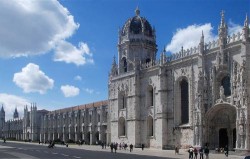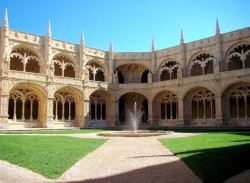The Jeronimos Monastery dates back to the early 16th century. It was commissioned when King Manuel I asked the Pope for permission to build it in thanks to the Virgin Mary for the successful voyage to India of the great explorer, Vasco de Gama.
Construction began in 1501 on the site of a hermitage which was founded by Henry the Navigator, and where Vasco da Gama and his crew spent their last night in Lisbon, giving prayer before leaving on their historic voyage.

The Jeronimos Monastery was inhabited by monks of the order of Saint Jerome, who were tasked with celebrating a daily mass for the sailors and for the king’s soul.
The monks were also tasked with hearing confessions and providing spiritual counsel to the intrepid seafarers who set sail on their voyages of discovery from Belem, here in the heart of Lisbon.
The site has been listed as a UNESCO World Heritage Site for its historical significance and for its architectural importance, as one of the greatest examples of art and architecture in Portugal during the time of the discoveries. It is also the mausoleum of King Manuel I and his successors, making it one of the most important buildings in Portugal.
The Jeronimos Monastery was designed by architect Diogo de Boitaca, who was responsible for the ground-breaking Igreja de Jesus in Setubal. As the project continued, Diogo de Boitaca was succeeded first by Joao de Castilho of Spain, Diogo de Torralva of Portugal and finally Jeronimo de Ruao.
Much of the monastery was decimated by the great earthquake of 1755 which damaged huge swathes of Lisbon. However it was thankfully not destroyed completely and has undergone a number of restoration projects in the 250 years since.
Following the dissolution of the monasteries in 1833 the building reverted to being the property of the state, after which it was used by a Lisbon children’s charity until mid-way through the Second World War. It is now open to the public and is well worth a visit both for its historical significance and for its delightful Manueline architecture.
The main entrance to the Jeronimos Monastery is via the south portal, which was designed by de Castilho. Here the central pillar is adorned by a statue of Henry the Navigator and further pillars inside the building are decorated with figurative sculptures, forming vaults over three aisles.
Head through the west door to admire the cloisters, whose stonework is even more impressive than that of the main church. Also designed by de Castilho, the cloisters are on two levels and are adorned on practically every surface with highly elaborate Manueline sculptural pieces.
Many important figures from Portugal’s rich past are entombed in the monastery.
These include King Manuel I as well as other members of Portuguese royalty, plus explorer Vasco de Gama and several literary figures including the poets Herculano and Fernando Pessoa.
Don’t miss the opportunity to visit the nearby Tower of Belem, which also forms part of the World Heritage Site.
Jeronimos Monastery
Praça do Imperio
1400-206 Lisbon
Portugal
Tel: +351 213 620 034
Fax: +351 213 639 145
Email: mjeronimos@igespar.pt
www.mosteirojeronimos.pt



